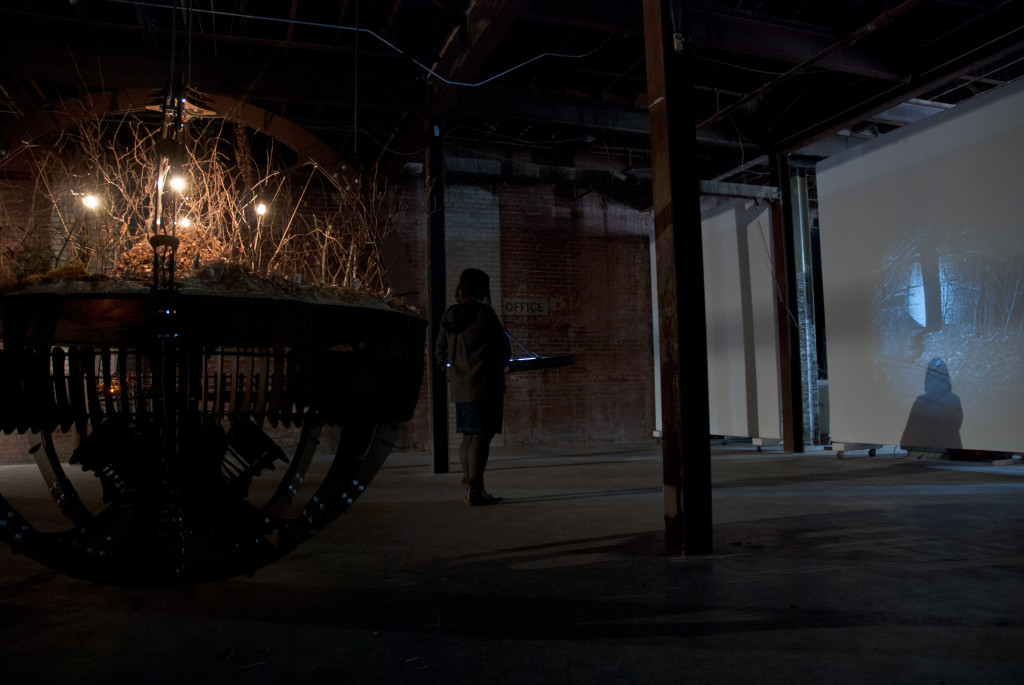

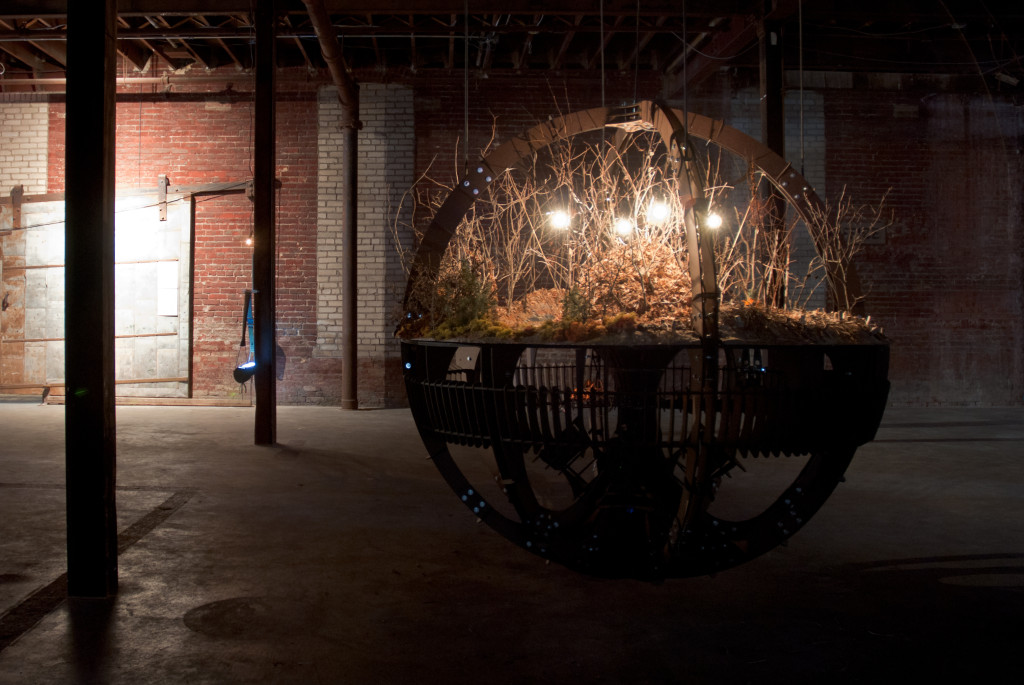





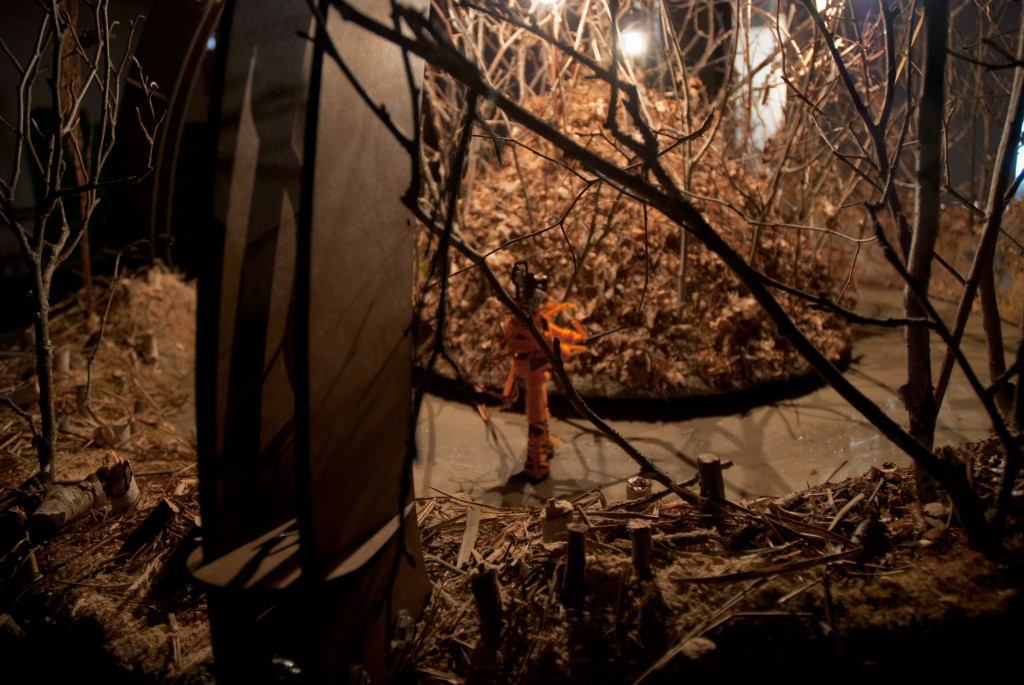
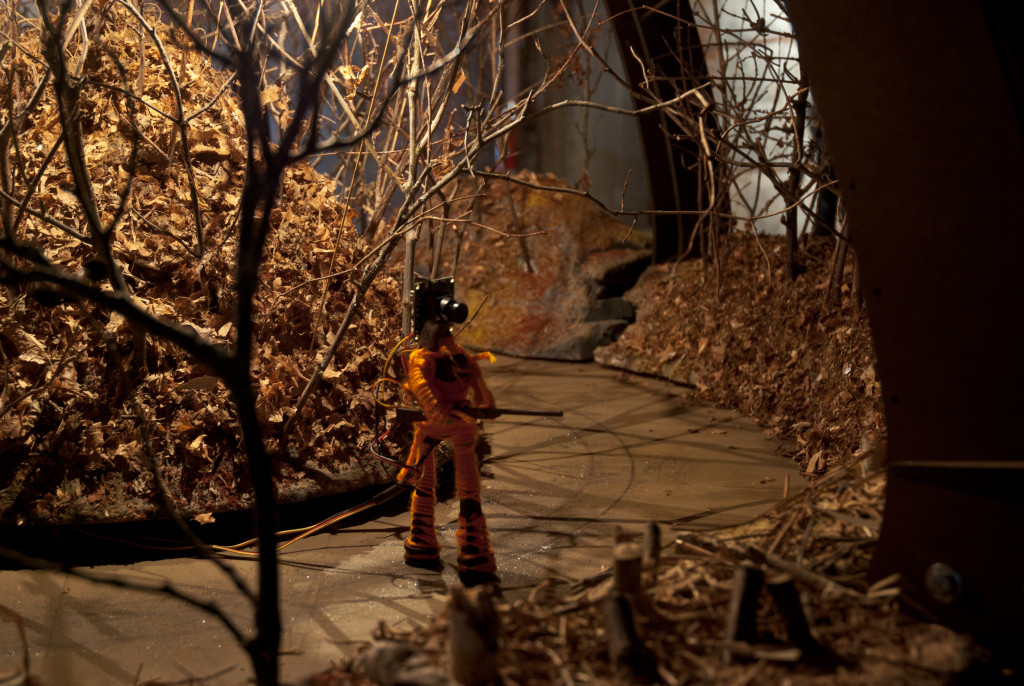
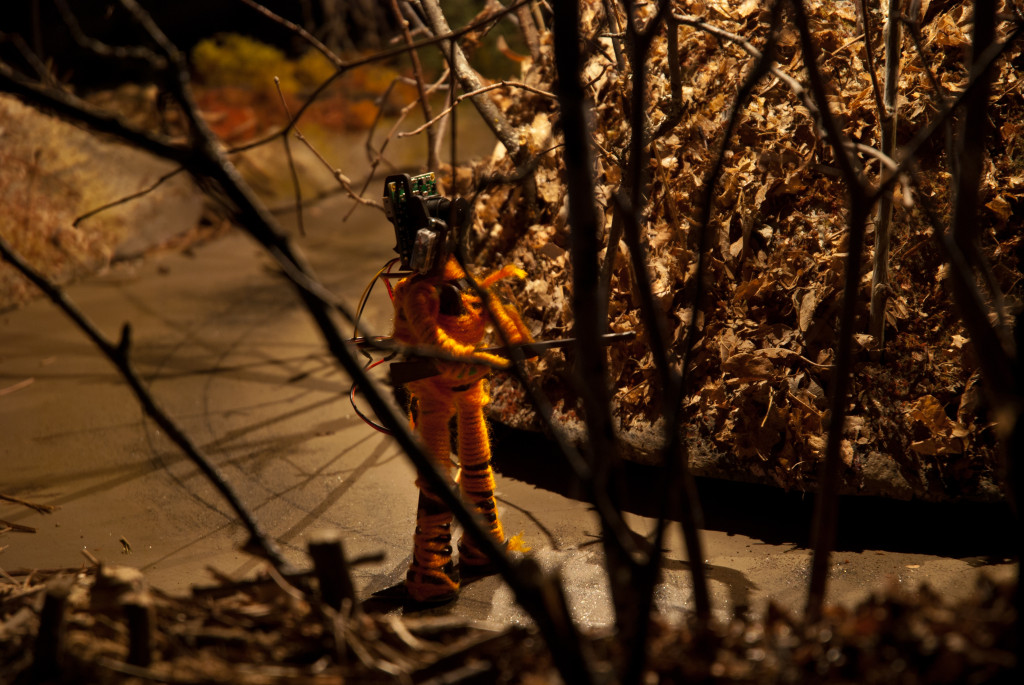


Drew Anderson, Near the Ghosts of Sugarloaf
“Art’s aspiration to link human consciousness with technology is still alive and well.”
Near the Ghosts of Sugarloaf
Technology as a creative medium has led me to the threshold of a miniature world, inhabited by small cameras, projectors, and puppets. I cannot claim to be a bona fide puppeteer, but I am making inroads in mechanical, miniature theater. With analog and digital technology I orchestrate tiny robotic figures, or automatons, and mix in other visual and interactive elements, such as projections and biomedical technology. Heart-rate sensors allow me to capture the human pulse digitally and render the digital into another form, such as mechanized motion or light. I’m interested in the displacement of the heartbeat outside the body and the experience of the real and artificial pulsing together.
My projection work stems from my collaborations with the collective Minneapolis Art on Wheels, whose outdoor projections range from large-scale drawings displayed on buildings to tiny animations beamed on sidewalks. Mobility is important to MAW and recently inspired the creation of a handheld, portable projector.
A similar device plays a pivotal role in my latest work, Near the Ghosts of Sugarloaf. This piece draws from my experiences deer hunting in northern Minnesota and deploys a miniature automaton and landscape in the likeness of a deer hunter and boreal forest. What the puppet hunter sees via a small camera attached to its head is broadcast live to a pulse-sensitive portable projector. Viewers may wander throughout the Soap Factory with this device in search of projection surfaces. In the projected image, participants see the miniature landscape through the eye of the puppet. Through the “eyes of the projection,” they intimately experience the hunt modulated by the rhythm of their pulse captured through the stock of the projection device.
The miniature realm is appropriate for my relatively small and remote world of hunting. It deals first with the divide between my personal activity as a hunter and the emotions I intend to convey. Accuracy is obviously impossible, especially in an urban environment like the Soap Factory, yet my miniature theater deliberately owns that irony and exploits it in a way unique to puppetry. The work’s playful abstraction of my subject relays a mood true to the forest in which I hunt and conjures the spirit of the hunt. Puppetry and technology allow the story to unfold as both an artificial reality and an evocative experience. I want to continue mixing technology and traditional art forms as open tools for telling stories in a new form.
Background
Does technology bring us closer to nature, or does it distance us from it? Drew Anderson’s Near the Ghosts of Sugarloaf asks viewers to ponder this question.
Anderson’s most powerful memories are drawn from family hunting trips “up north” in woods around Floodwood, Minnesota, northwest of Duluth. Alone in the woods, taking in the smells of the earth, he says, “you can hear every footstep, the wind, your own heart beating.” Anderson’s life in the city could not be more different. A lasercutting technician by day, he is a member of the Minneapolis Art on Wheels new-media artists collective by night. In this collective he works with computer and video technology to produce public art that is projected on the sides of buildings through the city with the aim of prompting public discussion about issues that matter—or just to have fun.
Anderson’s two worlds collide in Near the Ghosts of Sugarloaf, which is a puppet theater, landscape panorama (made of branches and twigs gathered from the forest around Floodwood), and a viewing and projection machine designed to share the artist’s experience of hunting with his viewers. Suspended in the middle of the unheated, industrial outer gallery of the Soap Factory, this satellite-like orb is a platform stage for a mechanical hunter-puppet with a camera for eyes. This diminutive mechanical automaton is an unlikely artistic medium for sharing profound personal experiences, but it leads in that direction. It is a mechanical art interface that entwines perceptions and attempts to merge human consciousness.
Holding a little rifle in its mechanical hands, the puppet is the artist’s surrogate self as a hunter roaming the forest. The viewer/participant mirrors the puppet when he or she takes hold of the installation’s rifle accessory, which vibrates as its sensors register the user’s beating heart. The rifle accessory becomes a mobile projector that throws incoming images from the puppet’s eyes onto the dilapidated gallery walls, all the while emitting the sound of steps crushing leaves underfoot. With rifle accessory in hand, heartbeat pulsating, and forest scenes dancing on the walls of the rough, chilly gallery interior, the perceptions of the participant and the puppet overlap and merge; momentarily coupled, together they are a wandering, sensing, hunting machine. Art’s aspiration to link human consciousness with technology is still alive and well.
Artist Statement
My art explores human stress that is both psychological and physical. I often use the concepts of time and rhythm to embody human emotion. The perception of time as an opposing force intrigues me, because in a deadline, routine, or test, the obstacle is time. I also admire the rhythm of the body when it undertakes a time-controlled task. Whether that task is manual labor or preparing a meal, an aspect of repetition and a sense of pace are involved. Video installation, kinetic sculpture, and interactive technology are my primary mediums, and over the past two years, I have explored how to cross these mediums and best represent my subject.
Biography
b. 1988, Duluth
works Minneapolis
mentor: Christopher Baker
Drew Anderson grew up in Cloquet, Minnesota. He studied English, music, and art at the University of Minnesota, Twin Cities and graduated in 2010 with an individually designed degree. He is a research assistant for artists Ali Momeni and Jenny Schmid and has participated in several of their works, including Momeni and Schmid’s Battle of Everyouth in the 2011 Northern Spark Festival, Minneapolis; Schmid’s VLD SK8R GRL, 2011, Istanbul, Turkey; and Momeni and Schmid’s Department of Smoke and Mirrors, 2012, Wellesley, Massachusetts. He lives in Minneapolis, where he is an active member of the Minneapolis Art on Wheels collective and works as a laser-cutter technician for the University of Minnesota’s Department of Art.